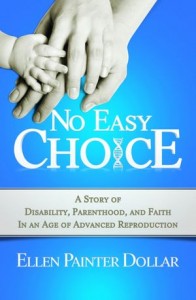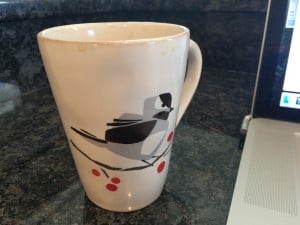*This is an excerpt from the introduction to my book, No Easy Choice: A Story of Disability, Parenthood, and Faith in an Age of Advanced Reproduction, which will be released next Tuesday, January 17, by Westminster John Knox Press.*
 We have been in the emergency room (ER) for several hours and have reached that point when things are calm, almost—unbelievably—relaxing. My nearly four-year-old daughter, Leah, is lying on a gurney next to me, spaced out on sedatives and pain relievers and watching a Winnie the Pooh video for the third time. I am digging peanut M&M’s out of my purse, eating them slowly, one by one, so the nurses and doctors going in and out won’t think me insensitive for chowing down on vending-machine food while my daughter lies there pale and defeated. Now that we are beyond the worst—the first harrowing moments of knowing that Leah has just broken another bone (this time both left forearm bones, so unmistakably, heartsinkingly broken, bent at a 45-degree angle), the anxious conversations with the triage nurses, the IV and X-ray and sedation and casting—I need a sugar rush.
We have been in the emergency room (ER) for several hours and have reached that point when things are calm, almost—unbelievably—relaxing. My nearly four-year-old daughter, Leah, is lying on a gurney next to me, spaced out on sedatives and pain relievers and watching a Winnie the Pooh video for the third time. I am digging peanut M&M’s out of my purse, eating them slowly, one by one, so the nurses and doctors going in and out won’t think me insensitive for chowing down on vending-machine food while my daughter lies there pale and defeated. Now that we are beyond the worst—the first harrowing moments of knowing that Leah has just broken another bone (this time both left forearm bones, so unmistakably, heartsinkingly broken, bent at a 45-degree angle), the anxious conversations with the triage nurses, the IV and X-ray and sedation and casting—I need a sugar rush.
The staff at the children’s hospital have all commented on my pregnant belly, asking me if I know what we’re having (another girl) and if I’ll be delivering the baby across the street at the main city hospital. Yes, I answer—though the hushed, dark-paneled delivery suites seem, at this moment, miles away from this bright room where crutches of all sizes hang from wall pegs as flat-headed, one-legged observers of children in anguish and parents aching over their little ones’ broken limbs. But those delivery suites are not so far away after all. Our baby will be born there in just four days.
The pivotal times in our journey toward having a second baby were always, it seemed, accompanied by one of Leah’s fractures. So this ER visit just a few days before I was to give birth fit the pattern. I tried to read meaning into this coincidence, which was probably a silly exercise given how often Leah broke bones during the two years when we were so focused on having a second baby. But maybe it wasn’t so silly. Because our decisions about our second child revolved around Leah and her diagnosis of osteogenesis imperfecta (OI), a genetic disorder better known as “brittle-bone disease.” Frequent broken bones, often as the result of little or no trauma, are the hallmark of OI.
Leah did not walk until she was two-and-a-half because of weakness in her muscles and joints. Because she was not fully mobile, she was spared bone fractures for her first two years. In fact, her first fracture happened on her second birthday, when she fell while climbing on her new child-size couch—purchased explicitly to provide a safer alternative to climbing around on the full-size couch. I could not make up a more appropriate introduction to the illogical, unpredictable nature of this disorder. Kids with OI can have spectacular falls and be fine, and they can break bones during the most mundane activities, like climbing around on a minicouch.
When Leah finally started walking several months after that fracture healed, she also started falling, and broke three bones in three months that first summer she was mobile. We then had a glorious nine months without a fracture, during which she started preschool and became truly active for the first time in her life. Then summer came again—a fracture of the tibia and fibula (both lower leg bones) in June, followed by the broken arm that landed us in the ER four days before our second daughter’s birth. Both of these last fractures were gruesome, ugly things, with bones bent at stomach-turning angles and huge bruises instantly swelling and discoloring her tender skin. Like most of her other fractures, they both happened in our living room when I was within arm’s reach.
Like other parents, I worry about my children out in the world: Will they remember to look both ways when they cross the street? Do they understand that when I say, “Never go anywhere with anyone without asking Mom or Dad if it’s OK,” I really mean never, even if the guy down the street asks you to help him find his lost puppy? But unlike other parents, I cannot assume a relative absence of risk even when my daughter is playing in the living room while I leaf through the L. L. Bean catalog nearby. Neither my proximity nor the familiar confines of home can protect Leah from breaking.
Between her second and fourth birthdays, Leah had six broken bones. As much as I hated the harrowing hours following each fracture, they were a crisis, so I was propelled by adrenaline. The days and weeks that followed offered no such boost. I became weary and sad. The routines we hardly thought about in healthy times became dreaded chores, requiring brute strength and mental gymnastics. How to carry her—leg sticking straight out and encased in purple fiberglass—into our narrow bathroom, get her pants down, and sit her on the toilet with her leg elevated, all without hurting her?
We had to adjust to how this fracture would change our plans. The disappointments piled up, each one surprising me more than it should have. I kept forgetting that we inhabited a different world now, one in which making plans was foolhardy and the simplest of childhood rituals, from playing in the bathtub to attending a birthday party without Mom, were forbidden. There would be no swimming for Leah during our vacation to sweltering eastern North Carolina, where relatives run a church camp and have a swimming hole fifty yards from their front door. Our brand-new swing set, with its sturdy wide steps and not-too-high slide, chosen especially for Leah’s safety, sat empty and unused for most of the first summer we owned it. Each loss carved a chunk out of the optimism and faith I tried to cultivate in sunnier times. My pain was that of observer and absorber of my child’s agony. Leah did not talk about being sad, but she flew into rages more easily than usual, reverted to an arm-flapping ritual that she developed as a baby, wailed when I demanded that we make a trip to the bathroom because she hadn’t gone in five hours.
In this postfracture state, I inevitably questioned my desire for another child. The sheer logistics seemed overwhelming. Caring for a child with a newly broken bone while caring for other children is a challenge many parents have met—once or twice, maybe. But we could potentially be in this position several times a year for the next 10, 12, or 14 years. And we could easily have another child with OI. Because I have OI too, there is a 50 percent chance that any child of mine will inherit it. Any sane person, you would think, would have left well enough alone. I had a smart, beautiful daughter, healthy in all ways save her fragile bones. The thing is, I am sane—practical, level-headed, deliberate, thoughtful. I should have just accepted that one child was enough. But I could not. My husband, Daniel, could not.
As Leah was going through her relentless fracture cycle, Daniel and I were picking our way along a tangled and twisted path toward having another baby. We confronted questions—many of them unanswerable—concerning medicine, family, faith, and the reproductive choices available to twenty-first-century Americans with even a modest amount of disposable income. We struggled and cursed. We prayed and talked and e-mailed. And so we ended up in the ER that night, a child’s broken arm and a woman’s pregnant belly linked in ways no casual observer could imagine, leading characters in the mundane and extraordinary life that our family has been given.
Want to hear more of this story?
- Buy the book! It is available from pretty much any online book retailer, including Barnes and Noble, Amazon, and the Thoughtful Christian.
- If you are local, you are cordially invited to my book launch event on February 12, at which I will read an excerpt, answer questions, and have books available for purchase (along with some great food). Go to the Events page of my web site for more information.
- Consider whether your church, community, student, or book group might like me to lead a discussion about my book as well as the ethical and theological questions raised by reproductive technologies, such as IVF and genetic screening of embryos. Contact me to discuss possibilities. Again, locals can check out my Events page to find out where I’m speaking in the Hartford area in the coming months. I’d love to travel further afield and branch out from the Episcopal audiences that currently make up most of my event calendar, so get in touch if you have any ideas.











